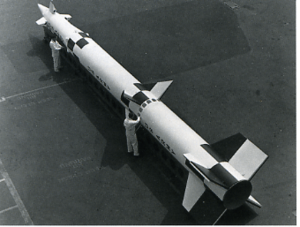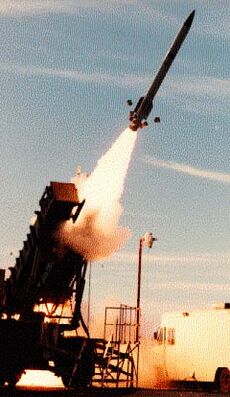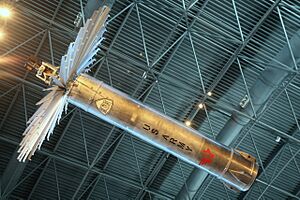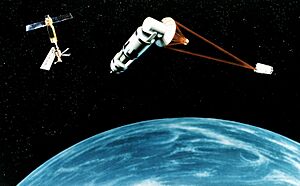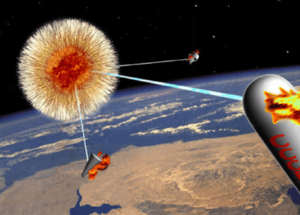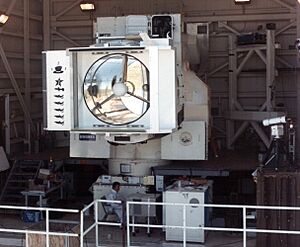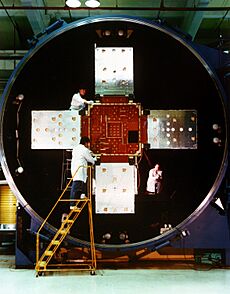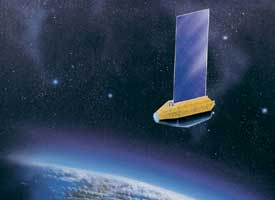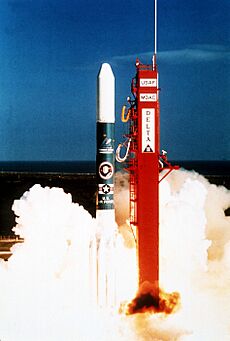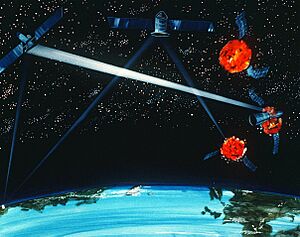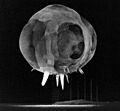Strategic Defense Initiative facts for kids
 |
|
| Agency overview | |
|---|---|
| Formed | 1984 |
| Preceding agency | |
| Dissolved | 1993 (renamed) |
| Superseding agency |
|
| Jurisdiction | Federal government of the United States |
The Strategic Defense Initiative (SDI), also known as the Star Wars program, was a plan to protect the United States from attacks by powerful nuclear weapons. These weapons included intercontinental ballistic missiles (ICBMs) and submarine-launched ballistic missiles (SLBMs). President Ronald Reagan announced this idea on March 23, 1983. He wanted American scientists to create a system that would make nuclear weapons useless. Some parts of this program are still being explored today by the Space Development Agency (SDA).
In 1984, the Strategic Defense Initiative Organization (SDIO) was created. It was part of the US Department of Defense. Its job was to develop these new defense systems. Scientists looked at many advanced ideas. These included laser weapons, particle beam weapons, and missile systems based on the ground and in space. They also studied special sensors and powerful computer systems. These computers would be needed to control a system with hundreds of combat centers and satellites around the world.
The SDIO also invested in basic research at labs, universities, and companies. This funding helped top scientists study high-energy physics, supercomputing, and new materials. This research also helped other science and engineering projects.
By the late 1980s, the program focused on a concept called "Brilliant Pebbles". This idea used small orbiting missiles, like tiny space rockets. It was expected to be cheaper and easier to build.
The SDI program was controversial. Some people worried it would make the Cold War worse. They thought it might start a new "arms race" where countries build more and more weapons. Senator Joe Biden said in 1986 that "Star Wars" was a "reckless" act. Declassified papers later showed that the Soviet Union was very worried about SDI. They feared it would make their nuclear weapons useless. As the Cold War ended in the early 1990s, support for SDI decreased. The program officially ended in 1993. The Clinton Administration then changed its focus to smaller, regional missiles. The agency was renamed the Ballistic Missile Defense Organization (BMDO).
In 2019, under President Trump, work on space-based interceptors started again. The Space Development Agency (SDA) now manages this program.
Contents
Developing Missile Defense Systems
Early Missile Defense Ideas
The US Army started thinking about defending against ballistic missiles after World War II. Early studies showed that stopping a fast rocket like the V-2 would be very hard. There wasn't enough time to react. However, longer-range missiles flew faster but also had longer flight times. This gave more time to detect them with radar from far away.
This led to projects like Nike Zeus and Safeguard Program. These aimed to build a defense system across the whole country against Soviet ICBMs. But the Soviets were building many missiles. Simple tricks like radar decoys made defense even harder. It seemed like it would cost $20 to defend for every $1 the Soviets spent on attack. This imbalance made it look like building a defense would only cause an arms race.
President Dwight D. Eisenhower asked ARPA to find new ideas. Their Project Defender looked at many systems. One idea was Project BAMBI. It used satellites with interceptor missiles. These missiles would attack Soviet ICBMs right after they launched. This "boost phase" intercept would destroy all warheads at once. But this system would be very expensive to operate. The US Air Force rejected it, and development stopped in 1963.
Building missile defenses became very controversial. By the late 1960s, public meetings about the Sentinel system drew thousands of angry people. After 30 years, only one such system was built. A single Safeguard base opened in 1975 but closed less than a year later.
The Soviet Union also had a missile defense system. The A-35 anti-ballistic missile system was built around Moscow. It was allowed under the 1972 Anti-Ballistic Missile Treaty. It used nuclear weapon-tipped missiles called A350 to intercept enemy missiles.
Ideas Leading to SDI
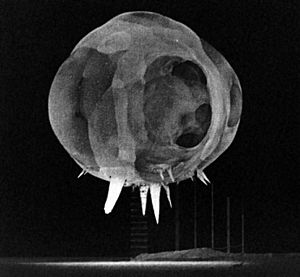
George Shultz, who was President Reagan's secretary of state, said that a 1967 lecture by physicist Edward Teller was important for SDI. Teller, known as the "father of the hydrogen bomb", talked about using nuclear weapons to defend against missiles. Reagan attended this lecture when he was governor of California.
The Soviet Union started developing laser weapons in the mid-1960s. By 1976, they were studying a space-based laser system called Polyus. They also worked on an anti-satellite system called Kaskad. In 1974, the Soviet Salyut 3 space station even had a revolver cannon that was successfully test-fired in orbit.
In 1979, Teller claimed the US needed to worry about the USSR's new space-based weapons. He was trying to get funding for his new X-ray laser weapon. At the time, there was no evidence that the Soviets were building such weapons.
In 1979, Reagan visited the NORAD base. He saw how the US could track missile attacks but couldn't stop them. Reagan felt this left the president in a terrible position. This feeling, combined with Teller's defense ideas, helped start SDI.
Lieutenant General Daniel O. Graham briefed Reagan on his "High Frontier" idea. This was an updated BAMBI concept. It proposed a multi-layered missile shield using ground- and space-based weapons. It aimed to track, intercept, and destroy ballistic missiles. This system would replace the idea of MAD. In 1981, Graham formed a group called High Frontier to research this shield.
Other groups were also working on anti-missile ideas. Some pushed for a powerful chemical laser in orbit. Teller's "O-Group" at LLNL developed Project Excalibur. This project suggested that a single X-ray laser could shoot down many missiles at once. These groups met with Reagan several times. In early 1983, military leaders also suggested shifting money from offensive weapons to new defensive systems.
The SDI Program and Its Evolution
Reagan's Announcement
On March 23, 1983, President Reagan announced the SDI program on TV. He said, "I call upon the scientific community... to give us the means of rendering these nuclear weapons impotent and obsolete." He wanted scientists to use their talents for world peace.
Strategic Defense Initiative Organization (SDIO)
The Strategic Defense Initiative Organization (SDIO) was set up in 1984. It was led by Lt. General James Alan Abrahamson. He had previously directed the NASA Space Shuttle program.
The SDIO looked at many ideas. These included particle-beam weapons and new types of nuclear shaped charges. They also invested in computer systems, smaller components, and sensors.
Initially, the program focused on large systems to stop a huge Soviet attack. SDIO mainly focused on "high-tech" solutions like lasers. Graham's "High Frontier" idea was not initially considered.
By 1986, many promising ideas were failing. Teller's X-ray laser, Project Excalibur, failed key tests. It was then only suggested for anti-satellite use. Other concepts, like the particle beam, also didn't work as hoped. Only the Space Based Laser seemed to have short-term potential.
APS Report and New Direction
The American Physical Society (APS) reviewed the SDI concepts. Their report, released in 1987, said that none of the technologies were ready. They needed huge improvements in power output. They concluded that no system could be deployed until the next century.
After this report, SDIO changed its focus. In late 1986, Abrahamson proposed a new system. It was a version of Graham's High Frontier, now called the "Strategic Defense System, Phase I Architecture." This name suggested more advanced systems would follow later.
This Strategic Defense System (SDS) was based on the Smart Rocks concept. It added ground-based missiles in the US. These missiles would attack warheads that the Smart Rocks missed. SDS also added low-flying satellites to track targets. The ground-based systems used today came from this idea.
Around this time, Lawrence Livermore National Laboratory introduced Brilliant Pebbles. This combined sensors and tracking from other systems into small, smart missiles. Studies showed this approach would be cheaper and more effective. In 1990, Brilliant Pebbles became the main model for SDS Phase 1.
Global Protection Against Limited Strikes (GPALS)
As the Cold War ended, the Warsaw Pact broke apart. A report suggested that a huge defense against a Soviet launch might not be needed anymore. Instead, the focus shifted to smaller missile threats. These might come from other countries as the Soviet Union broke up.
The new plan was called Global Protection Against Limited Strikes (GPALS). It focused on protecting against up to 200 nuclear missiles, not thousands. GPALS added new mobile ground-based missiles and more low-orbit satellites called Brilliant Eyes. These would feed information to the Pebbles.
President George H.W. Bush approved GPALS in 1991. This new system cut the estimated cost of SDI. It also aimed to protect the United States from attacks from anywhere in the world.
Ballistic Missile Defense Organization (BMDO)
In 1993, the Clinton administration changed the focus again. It moved towards ground-based interceptor missiles and regional defense systems. The SDIO was closed and renamed the Ballistic Missile Defense Organization (BMDO). Later, the George W. Bush administration renamed it the Missile Defense Agency and focused on a limited National Missile Defense.
Ground-Based Defense Programs
Extended Range Interceptor (ERINT)
The ERINT program was part of SDI's Theater Missile Defense. It built on earlier "hit-to-kill" technology. This means the missile destroys its target by directly colliding with it.
In 1987, a FLAGE missile (a test version of ERINT) hit a MGM-52 Lance missile in flight. ERINT was a prototype that flew faster and higher. Later, ERINT technology was used for the MIM-104 Patriot (PAC-3) missile.
Homing Overlay Experiment (HOE)
In the 1980s, the US Army studied "hit-to-kill" interceptors. These missiles would destroy incoming ballistic missiles by crashing into them. This avoided using nuclear-tipped interceptors.
The Homing Overlay Experiment (HOE) was the first successful "hit-to-kill" test. It intercepted a mock missile warhead outside Earth's atmosphere. The HOE used a kinetic kill vehicle (KKV). This KKV had an infrared sensor and a propulsion system. Once in space, it could open a 4-meter wide structure. This structure would increase its size to help it hit the target.
Four tests were done in 1983 and 1984. In the final test on June 10, 1984, the HOE successfully intercepted a mock Minuteman missile. It hit the target at a speed of about 6.1 kilometers per second. This happened at an altitude of over 160 kilometers.
The technology from HOE was later used in the Exoatmospheric Reentry-vehicle Interception System (ERIS) program.
ERIS and HEDI
Developed by Lockheed, the Exoatmospheric Reentry-vehicle Interceptor Subsystem (ERIS) was part of SDI's ground-based interceptor plan. It started in 1985. Although ERIS was never deployed, its technology was used in the Terminal High Altitude Area Defense (THAAD) system. It also helped develop the Ground-Based Interceptor used in today's Ground-Based Midcourse Defense (GMD) system.
Directed-Energy Weapon Programs
X-ray Laser
An early focus of SDI was X-ray lasers powered by nuclear explosions. The Excalibur idea aimed to focus the X-rays from an explosion using metal rods. Each rod would aim at a different ICBM. This way, one nuclear explosion could destroy many ICBMs. This would be cheaper for the US than for the Soviets to build more ICBMs. The idea started with satellites, but later moved to a "pop-up" concept. This meant launching the laser quickly from a submarine.
The first test, called the Cabra event, happened in 1983. The results were unclear. Since a nuclear explosion was used, the detector was destroyed. Critics said the X-ray laser would not be very useful for missile defense. However, the X-ray laser was only one of many systems SDI researched.
Even though the Cabra test was unclear, the X-ray laser program led to new knowledge. It helped develop laboratory X-ray lasers for biological imaging. It also led to new materials like Aerogel and better ways to detect breast cancer early.
Chemical Laser
Starting in 1985, the Air Force tested a deuterium fluoride laser called Mid-Infrared Advanced Chemical Laser (MIRACL). During a test, the laser successfully destroyed a Titan missile booster. The system was also tested on target drones for the US Navy. After SDI closed, MIRACL was tested as an anti-satellite weapon. The technology also helped develop the Tactical High Energy Laser (THEL). This laser is being tested to shoot down artillery shells.
The Missile Defense Agency's Airborne Laser program uses a chemical laser. It has successfully intercepted a missile taking off. This shows that an offshoot of SDI has achieved one of its main goals.
Neutral Particle Beam
In July 1989, the Beam Experiments Aboard a Rocket (BEAR) program launched a rocket. It carried a neutral particle beam (NPB) accelerator. The experiment showed that a particle beam would work as expected in space. It also showed no unexpected side effects when fired in space. The particle beam was still working after the rocket was recovered. Research on these accelerators, funded by SDIO, could one day help reduce nuclear waste.
Laser and Mirror Experiments
The High Precision Tracking Experiment (HPTE) was tested on June 21, 1985. A laser from Hawaii successfully tracked the experiment. It bounced the laser off the HPTE mirror.
The Relay Mirror Experiment (RME), launched in 1990, tested technologies for space-based relay mirrors. These mirrors would be used with an SDI directed-energy weapon system. The experiment showed that a laser could be sent from the ground to a satellite mirror. Then it could be sent back to another ground station with high accuracy.
The Low-power Atmospheric Compensation Experiment (LACE) satellite was launched with RME. It studied how the atmosphere distorts lasers. It also tested ways to correct this distortion. LACE helped improve SDI sensors. It also led to adaptive optics used in telescopes today.
Hypervelocity Railgun (CHECMATE)
Research on hypervelocity railguns was done for SDI. A railgun uses electric current to launch a projectile at very high speeds. The SDI railgun project, called CHECMATE, could fire two projectiles a day. This was a big improvement over earlier efforts. Railguns are attractive because they could shoot many targets quickly. They could also fire many times before needing to be refilled.
A railgun works by converting electrical potential energy into kinetic energy. An electric current flows through rails, creating a magnetic force. This force pushes a conductive projectile down the rails. Railguns can launch projectiles at over 2.4 kilometers per second.
Railguns face challenges. The rails wear out quickly from the high current. Early versions needed new rails after each shot. Projectiles also experience huge forces, over 100,000 g. They must be strong enough to survive firing and flying through the atmosphere at high speeds.
Besides destroying missiles, railguns were also planned for defending space platforms. This role expected future railguns to fire many shots quickly.
Space-Based Programs
Space-Based Interceptor (SBI)
Groups of interceptors were planned to be stored in orbital modules. In 1988, hover tests showed that the sensor and propulsion systems worked together. They also showed the sensor could switch its aiming point from a rocket's hot exhaust to its cooler body. This was a first for infrared ABM sensors. Final tests in 1992 used smaller parts, like those for a real interceptor. These prototypes later led to the Brilliant Pebbles program.
Brilliant Pebbles
Brilliant Pebbles was a non-nuclear system of satellite-based interceptors. They were watermelon-sized, teardrop-shaped projectiles made of tungsten. They would act as kinetic warheads, hitting targets at high speed. This system was designed to work with the Brilliant Eyes sensor system. The idea came from Lowell Wood in 1986.
The Pebbles were designed to work on their own. They wouldn't need constant guidance from other SDI sensors. This was a good way to save money. It was estimated to save $7 to $13 billion compared to the standard Phase I Architecture. Brilliant Pebbles later became a main part of the Bush Administration's SDI plan.
John H. Nuckolls, a director at Lawrence Livermore National Laboratory, called it "The crowning achievement of the Strategic Defense Initiative." Some technologies from SDI were used in later projects. For example, the sensors and cameras for Brilliant Pebbles were used in the Clementine mission.
Even though it was seen as one of the most capable SDI systems, the Brilliant Pebbles program was canceled in 1994 by the BMDO.
Sensor Programs
SDIO researched sensors for visible light, ultraviolet, infrared, and radar. This research later led to the Clementine mission. Like other parts of SDI, the sensor system was initially very large. But after the Soviet threat decreased, it was scaled back.
Boost Surveillance and Tracking System (BSTS)
The Boost Surveillance and Tracking System was part of SDIO in the late 1980s. It was designed to detect missile launches, especially during their "boost phase" (when they first take off). When the SDI program shifted to theater missile defense in the early 1990s, BSTS was transferred to the Air Force.
Space Surveillance and Tracking System (SSTS)
The Space Surveillance and Tracking System was designed to track ballistic missiles during their mid-course phase (when they are flying through space). It was meant to work with BSTS. However, it was later scaled down in favor of the Brilliant Eyes program.
Brilliant Eyes
Brilliant Eyes was a simpler version of SSTS. It focused on theater ballistic missiles instead of ICBMs. It was meant to work with the Brilliant Pebbles system.
Brilliant Eyes was later renamed Space and Missile Tracking System (SMTS). It was scaled back even more under BMDO. In the late 1990s, it became part of the Air Force's Space Based Infrared System (SBIRS).
Other Sensor Experiments
The Delta 183 program used a satellite called Delta Star. It tested several sensor technologies. Delta Star carried a thermographic camera, an infrared imager, and other sensors. It observed missile launches, including some that released liquid propellant to avoid detection. Data from these experiments led to advances in sensor technologies.
Countermeasures
In war, countermeasures are actions to reduce how vulnerable you are. This can include using chaff or decoys. It also means strategies that use a weakness in an enemy system. For example, adding more MIRV warheads can be cheaper than the interceptors needed to stop them. Attacking parts of the defense system is also a countermeasure.
Countermeasures have always been important in war. But with SDI, they became especially important. This was because of the high cost of the system. Also, SDI planned for a huge, complex attack. Many proposed weapons were based in outer space.
Today's United States national missile defense system is designed for a limited attack. But SDI planned for a massive attack by a very advanced enemy. This raised big questions about the cost of defending against anti-ballistic missile defense countermeasures.
For example, if it was much cheaper to add attacking warheads than to add defenses, an enemy could simply build more weapons. This idea of being "cost effective at the margin" was first stated by Paul Nitze in 1985.
Also, SDI planned for many space-based systems in fixed orbits. These could be targeted by an advanced enemy. This would mean the defense system would need to defend itself or have more units to replace losses.
A smart attacker could use decoys, shielding, or other tricks. This would make it much harder and more expensive to intercept the real warheads. SDI's design had to consider these countermeasures and their costs.
Timeline of SDI
Timeline generation failed: More than 10 errors found
Line 19: at:03/08/1983 text:"March 23, 1983: Reagan's "Star Wars" speech."
- Invalid attribute 'Wars"' ignored.
Specify attributes as 'name:value' pair(s).
Line 19: at:03/08/1983 text:"March 23, 1983: Reagan's "Star Wars" speech."
- Invalid attribute 'speech."' ignored.
Specify attributes as 'name:value' pair(s).
Line 19: at:03/08/1983 text:"March 23, 1983: Reagan's "Star Wars" speech."
- Invalid attribute 'Star' ignored.
Specify attributes as 'name:value' pairs.
Line 21: at:06/10/1984 text:"June 10, 1984: The Army showed "hit-to-kill" ability in the Homing Overlay Experiment (HOE)."
- Invalid attribute 'ability' ignored.
Specify attributes as 'name:value' pair(s).
Line 21: at:06/10/1984 text:"June 10, 1984: The Army showed "hit-to-kill" ability in the Homing Overlay Experiment (HOE)."
- Invalid attribute 'in' ignored.
Specify attributes as 'name:value' pair(s).
Line 21: at:06/10/1984 text:"June 10, 1984: The Army showed "hit-to-kill" ability in the Homing Overlay Experiment (HOE)."
- Invalid attribute 'the' ignored.
Specify attributes as 'name:value' pair(s).
Line 21: at:06/10/1984 text:"June 10, 1984: The Army showed "hit-to-kill" ability in the Homing Overlay Experiment (HOE)."
- Invalid attribute 'Homing' ignored.
Specify attributes as 'name:value' pair(s).
Line 21: at:06/10/1984 text:"June 10, 1984: The Army showed "hit-to-kill" ability in the Homing Overlay Experiment (HOE)."
- Invalid attribute 'Overlay' ignored.
Specify attributes as 'name:value' pair(s).
Line 21: at:06/10/1984 text:"June 10, 1984: The Army showed "hit-to-kill" ability in the Homing Overlay Experiment (HOE)."
- Invalid attribute 'Experiment' ignored.
Specify attributes as 'name:value' pair(s).
Line 21: at:06/10/1984 text:"June 10, 1984: The Army showed "hit-to-kill" ability in the Homing Overlay Experiment (HOE)."
- Invalid attribute '(HOE)."' ignored.
Specify attributes as 'name:value' pair(s).
Line 21: at:06/10/1984 text:"June 10, 1984: The Army showed "hit-to-kill" ability in the Homing Overlay Experiment (HOE)."
- Invalid attribute 'hit-to-kill"' ignored.
Specify attributes as 'name:value' pairs.
Images for kids
See also
 In Spanish: Iniciativa de Defensa Estratégica para niños
In Spanish: Iniciativa de Defensa Estratégica para niños
- Anti-ballistic missile
- Anti-satellite weapons
- Ballistic Missile Defense Organization (BMDO)
- Comparison of anti-ballistic missile systems
- Directed-energy weapons
- Zenith Star
- Ground-Based Midcourse Defense (GMD)
- International Conference of Laser Applications
- Militarization of space
- Missile Defense Agency (MDA)
- Missile defense systems by country
- Polyus (spacecraft)
- Rockwell X-30 – partly funded by the SDIO
- THAAD missile defense system
- United States national missile defense
- United States Space Force


